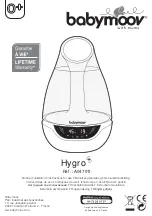
56
control transformer, the smoke alarm interlock, the airflow proving switch, or the optional voltage
monitor relay.
• If the dehumidifier uses a non-standard controller, or if the compressors are cycled by the
building management system, consult with the controls contractor.
• Confirm that the compressor “knife” switches from air balancing section have been closed.
4.3 High Pressure Alarms/Readings Above 575 PSIG
The unit contains a pressure transducer and control sequence that will interrupt power to the compressor
if the refrigeration system pressure is excessively high. The alarm will be active on the local display and
the building management system (if equipped). The alarm can be reset at the main alarm screen on the
display.
• Check that all service valves and ball valves in the compressor discharge line are fully open.
• Verify that the reheat condenser is clean and free from debris. Use a Magnehelic® or an inclined
manometer to check the air volume through the reheat condenser. See Section 3.2 for more
detailed instructions.
• Check that there is adequate water flowing through the pool water condenser (on units equipped
with this option). Verify the operation of the water flow switch.
• Check the remote condenser fuses, fan motors, and fan cycling switches (on units equipped with
this option). Verify that the fans are not obstructed and that they blow the air vertically upward.
• Check the three-way heat reclaim valve for proper operation. This valve, which is installed in the
compressor discharge line, diverts hot refrigerant vapor to the various condensers (on units
equipped with optional pool water heating or remote condensers). The valve spool may be stuck
in the middle of the valve, where it blocks the outlets to both condensers. You can verify its
operation by first running the compressor and then measuring the temperature of both
condenser outlets. If the valve is shifting normally, the active condenser outlet will heat up rapidly.
• Check for air or other non-condensables in the refrigeration circuit. Desert Aire installs purge
ports in the highest point of each condenser’s discharge line. To purge these gases from the
system, temporarily run the compressor while you energize the selected condenser. Shut the
compressor off, but continue to circulate cooling air or water through the condenser. Slowly
depress the Schrader core at the high point purge of the condenser. You can do this
procedure to keep the system running, but it is a temporary fix. It is not a longterm substitute for
proper evacuation with a vacuum pump.
• If the dehumidifier uses an outdoor air duct with a field-installed preheating coil, verify that the
coil is only active during the heating season.
• If the system is overcharged or excessively cold, migrating refrigerant can liquefy and fill a
condenser and its discharge line during the “off-cycle”. If the compressor starts and the
three-way valve shifts to this flooded condenser, the high pressure switch will trip almost
immediately. Remote outdoor condensers are particularly susceptible to this problem during the
winter months.
Desert Aire - SA Manual
Summary of Contents for SA Series
Page 2: ...2 ...
Page 6: ...6 Desert Aire SA Manual ...
Page 38: ...38 Desert Aire SA Manual ...
Page 72: ...72 Desert Aire SA Manual ...
Page 73: ...73 Desert Aire SA Manual ...
Page 74: ...74 Desert Aire SA Manual ...
Page 75: ...75 Desert Aire SA Manual ...
Page 76: ...76 Desert Aire SA Manual ...
Page 77: ...77 Desert Aire SA Manual ...
















































